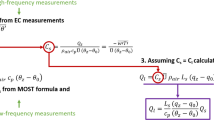Abstract
A numerical model is developed to study the hopping motion of sand grains (saltation) in neutral atmospheric surface layers. Saltation is considered as a self-limiting process governed by the interaction of four components: aerodynamic entrainment, particle motion, splash entrainment and wind modification. The model comprises a large eddy simulation model for atmospheric surface-layer flows, a Lagrangian model for particle trajectories and a statistical description for aerodynamic entrainment and splash entrainment. The numerical simulation is focused on the aspects of saltation that are not well understood from experimental studies, including the role of splash, the evolution of wind and momentum flux profiles, and the effective roughness length, z 0s . It is shown that for splash to be effective, the surface friction velocity must exceed a critical value for a given particle size. The numerically estimated z 0s is compared with the analytical model of Raupach and the experimental data of Gillette et al. The model is also used to calculate the streamwise sand drift and the numerical results found to be in agreement with the existing wind-tunnel measurements.
Similar content being viewed by others
References
Anderson, R. S. and Haff, P. K.: 1991, ‘Wind Modification and Bed Response during Saltation of Sand in Air', Acta Mechanica Suppl. 1, 21-51.
Bagnold, R. A.: 1941, The Physics of Blown Sand and Desert Dunes, Chapman and Hall, 265 pp.
Bradley, E. F.: 1968, ‘A Micrometeorological Study of Velocity Profiles and Surface Drag in the Region Modified by a Change in Surface Roughness', Quart. J. Roy. Meteorol. Soc. 94, 361-379.
Buckley, R.: 1987, ‘The Effect of Sparse Vegetation on the Transport of Dune Sand by Wind', Nature 325, 426-428.
Chamberlain, A. C: 1983, ‘Roughness Length of Sea, Sand and Snow', Boundary-Layer Meteorol. 25, 405-409.
Detering, H.W. and Etling, D.: 1985, ‘Application of the κ-ε Turbulence Model to the Atmospheric Boundary Layer', Boundary-Layer Meteorol. 33, 113-133.
Greeley, R. and Iversen, J. D.: 1985, Wind as a Geological Process, Cambridge University Press, New York, 333 pp.
Gillette, D. A., Marticorena, B., and Bergametti, G.: 1998, ‘Change in the Roughness Height by Saltating Grains: Experimental Assessment, Test of Theory and Operational Parameterization', J. Geophys. Res. 103, 6203-6209.
Li, Y. and Baldacchino, L.: 1995, ‘Implementation of Some Higher-Order Convection Schemes on Non-Uniform Grids', Int. J. Numerical Meth. Fluids 21, 2101-0000.
McEwan, I. K. and Willetts, B. B.: 1991, ‘Numerical Model of the Saltation Cloud', Acta Mechanica Suppl. 1, 53-66.
McKenna Neuman, C. and Nickling, W. G.: 1994, ‘Momentum Extraction with Saltation: Implications for Experimental Evaluation of Wind Profile Parameters', Boundary-Layer Meteorol. 68, 35-50.
Marticorena, B., Bergametti, G., Aumont, B., Callot, Y., N'Doumé, C., and Legrand, M.: 1997, ‘Modelling the Atmospheric Dust Cycle, 2, Simulation of Saharan Dust Sources', J. Geophys. Res. 102, 4387-4404.
Mitha, S., Tran, M. Q., Werner, B. T., and Haff, P. K.: 1986, ‘The Grain-Bed Impact Process in Aeolian Saltation', Acta Mechanica 63, 267-278.
Morsi, S. A. and Alexander, A. J.: 1972, ‘An Investigation of Particle Trajectories in Two-Phase Flow Systems', J. Fluid Mech. 55, 193-208.
Owen, R. P.: 1964, ‘Saltation of Uniform Grains in Air', J. Fluid Mech. 20, 225-242.
Raupach, M. R.: 1991, ‘Saltation Layers, Vegetation Canopies and Roughness Lengths', Acta Mechanica Suppl. 1, 83-96.
Rice, M. A., Willetts, B. B., and McEwan, I. K.: 1995, ‘An Experimental Study of Multiple Grain-Size Ejecta Produced by Collisions of Saltating Grains with a Flat Bed', Sedimentology 42, 695-706.
Sorensen, M.: 1991, ‘An Analytic Model of Wind-Blown Sand Transport', Acta Mechanica Suppl. 1, 67-81.
Shao, Y. and Raupach, M. R.: 1992, ‘The Overshoot and Equilibration of Saltation', J. Geophys. Res. 97, 20559-20564.
Shao, Y, Raupach, M. R., and Findlater, P. A.: 1993, ‘Effect of Saltation Bombardment on the Entrainment of Dust by Wind', J. Geophys Res. 98, 12719-12726.
Shao, Y., Raupach, M. R., and Leys, J. F.: 1996, ‘A Model for Predicting Aeolian Sand Drift and Dust Entrainment on Scales from Paddock to Region', Aust. J. Soil Res. 34, 309-342.
Shao, Y. and Leslie, L. M.: 1997, ‘Wind Erosion Prediction over the Australian Continent', J. Geophys. Res. 102, 30,091-30,105.
Ungar, J. E. and Haff, P. K.: 1987, ‘Steady State Saltation in Air', Sedimentology 34, 289-299.
Werner, B. T. and Haff, P. K.: 1988, ‘The Impact Process in Aeolian Saltation: Two-Dimensional Simulation', Sedimentology 35, 189-196.
Werner, B. T.: 1990, ‘A Steady-State Model of Wind-Blown Sand Transport', J. Geol. 98, 1-17.
White, B. R. and Schultz, J. C.: 1977, ‘Magnus Effect in Saltation', J. Fluid Mech. 81, 459-473.
Author information
Authors and Affiliations
Rights and permissions
About this article
Cite this article
Shao, Y., Li, A. Numerical Modelling of Saltation in the Atmospheric Surface Layer. Boundary-Layer Meteorology 91, 199–225 (1999). https://doi.org/10.1023/A:1001816013475
Issue Date:
DOI: https://doi.org/10.1023/A:1001816013475




